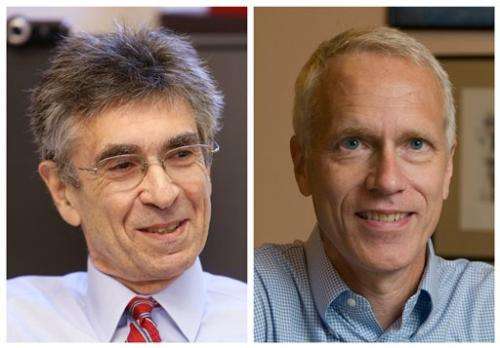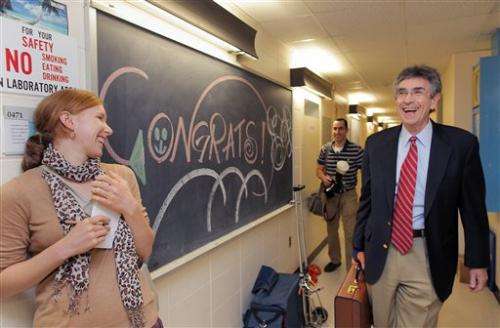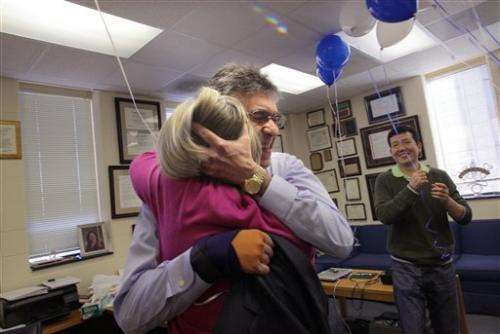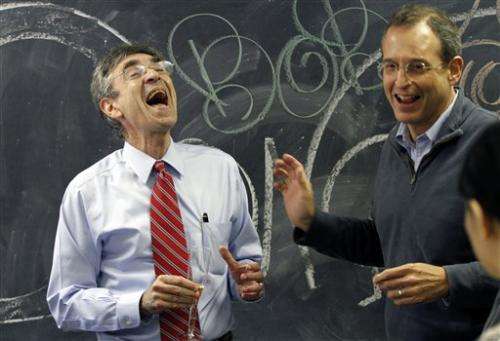Duke, Stanford scientists win Nobel for chemistry (Update 5)

Two Americans won the Nobel Prize in chemistry Wednesday for studies of how the cells in our bodies pick up signals as diverse as hormones, smells, flavors and light—work that is key to developing better medicines.
Those signals are received by specialized proteins on cell surfaces. Dr. Robert Lefkowitz and Dr. Brian Kobilka made groundbreaking discoveries about the inner workings of those proteins, mainly in the 1980s, the Royal Swedish Academy of Sciences said.
The proteins are called G-protein-coupled receptors. Many of today's drugs—maybe about half—act on these receptors, including beta blockers and antihistamines. Experts say the prize-winning work and subsequent research is helping scientists as they try to improve current drugs and develop new ones.
The receptors pick up signals outside a cell and relay a message to the interior.
"They work as a gateway to the cell," Lefkowitz told a news conference in Stockholm by phone. "As a result, they are crucial ... to regulate almost every known physiological process with humans."
Lefkowitz, 69, is an investigator at the Howard Hughes Medical Institute and professor at Duke University Medical Center in Durham, N.C.
Kobilka, 57, worked for Lefkowitz at Duke before transferring to Stanford University School of Medicine in California, where he is now a professor.
Lefkowitz said he was fast asleep when the Nobel committee called, but he didn't hear the phone because he was wearing ear plugs. So his wife picked up.

"She said, 'There's a call here for you from Stockholm,'" Lefkowitz told The Associated Press. "I knew they ain't calling to find out what the weather is like in Durham today."
He said he didn't have any "inkling" that he was being considered for the Nobel Prize.
"Initially, I expected I'd have this huge burst of excitement. But I didn't. I was comfortably numb," Lefkowitz said.
Kobilka said he found out around 2:30 a.m., after the Nobel committee called his home twice. He said he didn't get to the phone the first time, but that when he picked up the second time, he spoke to five members of the committee.
"They passed the phone around and congratulated me," Kobilka told AP. "I guess they do that so you actually believe them. When one person calls you, it can be a joke. But when five people with convincing Swedish accents call you, then it isn't a joke."

He said he would put his half of the 8 million kronor ($1.2 million) award toward retirement or "pass it on to my kids."
The academy said it was long a mystery how cells interact with their environment and adapt to new situations, such as when they react to adrenaline by increasing blood pressure and making the heart beat faster.
Scientists suspected that cells had some type of receptor for hormones and other substances, but they couldn't find any.
Lefkowitz managed to reveal receptors, such as one for adrenaline, and started to understand how that one works.
Kobilka, working with Lefkowitz, found the gene that tells the body how to make the adrenaline receptor, and it soon became clear that there was a whole family of receptors that look alike—a family that is now called G-protein-coupled receptors.

Since then, scientists have built up detailed knowledge about how those receptors work and how they are regulated. The two prize winners "have been at the forefront of this entire scientific journey," the Nobel committee said.
Kobilka moved on to Stanford after the gene discovery, and just last year he and his team there captured an image of a receptor at the moment it transferred the signal from a hormone to the interior of the cell. The academy called that "a molecular masterpiece."
Awarding the Nobel to Lefkowitz and Kobilka is "a fantastic decision," said Roger Sunahara, who studies how hormones activate the receptors at the University of Michigan. With detailed knowledge about the receptors, scientists can better understand how drugs work, which in turn helps them improve current medications and look for new ones, he said.
Drugs such as beta blockers, antihistamines and various psychiatric medicines have been around for some time, but before Lefkowitz and Kobilka's discoveries, their interaction with the human body wasn't fully understood, said Sven Lidin, chairman of the prize committee.

"All we knew was that they worked, but we didn't know why," Lidin said.
Mark Downs, chief executive of Britain's Society of Biology, said the critical role receptors play is now taken for granted.
"This groundbreaking work spanning genetics and biochemistry has laid the basis for much of our understanding of modern pharmacology as well as how cells in different parts of living organisms can react differently to external stimulation, such as light and smell, or the internal systems which control our bodies such as hormones," Downs said in a statement.
The U.S. has dominated the Nobel chemistry prize in recent years, with American scientists being included among the winners of 17 of the past 20 awards.
This year's Nobel announcements started Monday with the medicine prize going to John Gurdon of Britain and Japan's Shinya Yamanaka for their work on reprogramming cells. Frenchman Serge Haroche and American David Wineland won the physics prize Tuesday for work on quantum particles.
The Nobel Prizes were established in the will of 19th-century Swedish industrialist Alfred Nobel, the inventor of dynamite. The awards are always handed out on Dec. 10, the anniversary of Nobel's death in 1896.
Profiles of Nobel chemistry laureates
Following are snapshots of the 2012 winners of the Nobel Prize for Chemistry, Robert Lefkowitz and Brian Kobilka of the United States.
The pair were honoured for their work in describing G-protein-coupled receptors (GPCRs), which enable cells respond to body chemicals and environmental signals.
ROBERT LEFKOWITZ, 69, is a professor of biomedicine and biochemistry at Duke University in North Carolina.
The grandchild of Polish immigrants to the United States, he grew up as an only child in a two-bedroom apartment in New York's Bronx.
A voracious reader, he devoured his parents' books, medical fiction and detective stories, and decided while still at primary school that he wanted to become a physician.
He went to medical school at New York's Columbia University, where he finished first in his class.
During a two-year fellowship at the US National Institutes of Health, he threw himself into receptor biology, which was then a brand-new field of research.
In a tribute last year, the American Society for Clinical Investigation in its journal hailed Lefkowitz as "one of the true greats of contemporary medicine and biomedical research," singling out his persistence in the face of obstacles and generosity towards others.
He has gained more than 60 awards, including the US National Medal of Science. He is married, has five children and five grandchildren.
BRIAN KOBILKA, born in 1955, is a professor of molecular and cellular physiology at Stanford University School of Medicine in California.
He was born in Little Falls, a small rural community in central Minnesota, where his grandfather and father were bakers and his mother decorated the cakes.
Kobilka studied biology and chemistry at the University of Minnesota in Duluth, where he met his future wife, and then went to Yale to study medicine.
In 1984, he went to Duke University, where he worked as a post-doctoral researcher under his fellow Nobel laureate, Robert Lefkowitz. Together they put together the first genetic sequence of GPCRs.
Kobilka is described as tall, gangling, excruciatingly modest and self-effacing.
A profile of him, published by the science journal Nature, describes how he failed to sparkle at a job interview for the University of California at San Francisco.
"He was this shy, pale, Scandinavian-looking guy," Henry Bourne, the professor who ran the department, told Nature. "I thought, who is this guy? He's very strange, so modest, so quiet."
Bourne gave the job to the other applicant, but admitted:"We should have hired both of them."
Kobilka is the father of two children.
More information:
Nobel Committee announcement:
Smart receptors on cell surfaces
Your body is a fine-tuned system of interactions between billions of cells. Each cell has tiny receptors that enable it to sense its environment, so it can adapt to new situtations. Robert Lefkowitz and Brian Kobilka are awarded the 2012 Nobel Prize in Chemistry for groundbreaking discoveries that reveal the inner workings of an important family of such receptors: G-protein–coupled receptors.
For a long time, it remained a mystery how cells could sense their environment. Scientists knew that hormones such as adrenalin had powerful effects: increasing blood pressure and making the heart beat faster. They suspected that cell surfaces contained some kind of recipient for hormones. But what these receptors actually consisted of and how they worked remained obscured for most of the 20th Century.
Lefkowitz started to use radioactivity in 1968 in order to trace cells' receptors. He attached an iodine isotope to various hormones, and thanks to the radiation, he managed to unveil several receptors, among those a receptor for adrenalin: β-adrenergic receptor. His team of researchers extracted the receptor from its hiding place in the cell wall and gained an initial understanding of how it works.
The team achieved its next big step during the 1980s. The newly recruited Kobilka accepted the challenge to isolate the gene that codes for the β-adrenergic receptor from the gigantic human genome. His creative approach allowed him to attain his goal. When the researchers analyzed the gene, they discovered that the receptor was similar to one in the eye that captures light. They realized that there is a whole family of receptors that look alike and function in the same manner.
Today this family is referred to as G-protein–coupled receptors. About a thousand genes code for such receptors, for example, for light, flavour, odour, adrenalin, histamine, dopamine and serotonin. About half of all medications achieve their effect through G-protein–coupled receptors.
The studies by Lefkowitz and Kobilka are crucial for understanding how G-protein–coupled receptors function. Furthermore, in 2011, Kobilka achieved another break-through; he and his research team captured an image of the β-adrenergic receptor at the exact moment that it is activated by a hormone and sends a signal into the cell. This image is a molecular masterpiece – the result of decades of research.
Copyright 2012 The Associated Press. All rights reserved. This material may not be published, broadcast, rewritten or redistributed.

















